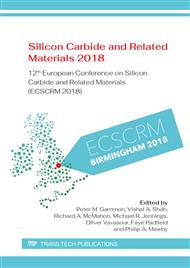[1]
R. M. Van Ginhoven, H. Jónsson, and L. R. Corrales, Silica glass structure generation for ab initio calculations using small samples of amorphous silica,, Phys. Rev. B, vol. 71, no. 2, p.024208, (2005).
DOI: 10.1103/physrevb.71.024208
Google Scholar
[2]
A. Roder, W. Kob, and K. Binder, Structure and dynamics of amorphous silica surfaces,, J. Chem. Phys., vol. 114, no. 17, p.7602–7614, (2001).
DOI: 10.1063/1.1360257
Google Scholar
[3]
G. Pacchioni, L. Skuja, and D. L. Griscom, Defects in SiO2 and Related Dielectrics: Science and Technology. Springer Netherlands, (2012).
DOI: 10.1007/978-94-010-0944-7
Google Scholar
[4]
T. Bakos, S. N. Rashkeev, and S. T. Pantelides, Reactions and Diffusion of Water and Oxygen Molecules in Amorphous,, Phys. Rev. Lett., vol. 88, no. 5, p.055508, (2002).
Google Scholar
[5]
W. Orellana, Energetic of nitrogen incorporation reactions in SiO2,, Appl. Phys. Lett., vol. 84, no. 6, p.933–935, (2004).
DOI: 10.1063/1.1646466
Google Scholar
[6]
M. S. Munde, D. Z. Gao, and A. L. Shluger, Diffusion and aggregation of oxygen vacancies in amorphous silica,, J. Phys. Condens. Matter, vol. 29, no. 24, (2017).
DOI: 10.1088/1361-648x/aa6f9a
Google Scholar
[7]
S. Plimpton, Fast Parallel Algorithms for Short – Range Molecular Dynamics,, J. Comput. Phys., vol. 117, p.1–19, (1995).
Google Scholar
[8]
A. C. T. Van Duin, S. Dasgupta, F. Lorant, and W. A. Goddard, ReaxFF: A reactive force field for hydrocarbons,, J. Phys. Chem. A, vol. 105, no. 41, p.9396–9409, (2001).
DOI: 10.1021/jp004368u
Google Scholar
[9]
M. Guidon, J. Hutter, and J. VandeVondele, Robust Periodic Hartree- Fock Exchange for Large-Scale Simulations Using Gaussian Basis Sets,, J. Chem. Theory Comput., vol. 5, no. 11, p.3010–3021, (2009).
DOI: 10.1021/ct900494g
Google Scholar
[10]
S. Goedecker, M. Teter, and J. Hutter, Separable dual-space Gaussian pseudopotentials,, Phys. Rev. B, vol. 54, no. 3, p.1703–1710, Jul. (1996).
DOI: 10.1103/physrevb.54.1703
Google Scholar
[11]
J. Hutter, M. Iannuzzi, F. Schiffmann, and J. Vandevondele, Cp2k: Atomistic simulations of condensed matter systems,, Wiley Interdiscip. Rev. Comput. Mol. Sci., vol. 4, no. 1, (2014).
DOI: 10.1002/wcms.1159
Google Scholar
[12]
M. Guidon, J. Hutter, and J. VandeVondele, Auxiliary Density Matrix Methods for Hartree{\textminus}Fock Exchange Calculations,, vol. 6, no. 8, p.2348–2364, (2010).
DOI: 10.1021/ct1002225
Google Scholar
[13]
M. Guidon, J. Hutter, and J. Vandevondele, Auxiliary density matrix methods for Hartree-Fock exchange calculations,, J. Chem. Theory Comput., vol. 6, no. 8, p.2348–2364, (2010).
DOI: 10.1021/ct1002225
Google Scholar
[14]
K. Vollmayr, W. Kob, and K. Binder, Cooling-rate effects in amorphous silica: A computer-simulation study,, Phys. Rev. B - Condens. Matter Mater. Phys., vol. 54, no. 22, p.15808–15827, (1996).
DOI: 10.1103/physrevb.54.15808
Google Scholar


